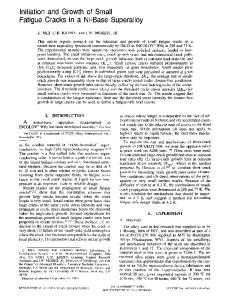The initiation and growth of fatigue cracks in a titanium aluminide alloy
- PDF / 3,858,667 Bytes
- 15 Pages / 597 x 774 pts Page_size
- 46 Downloads / 356 Views
I.
INTRODUCTION
TITANIUMaluminide alloys are thought to have promise for use at elevated temperatures in future gas turbine engines because they are much lighter than alloys currently in use and have higher specific strength and modulus than alloys currently used. t~] These materials are just reaching the stage of commercial production, and their mechanical properties are being more closely evaluated in anticipation of engineering use. Both ambient and elevated temperature properties are important. The intermetallic compound Ti3A1, on which these alloys is based, is brittle at ambient temperature, but this problem has been addressed by alloying,t2] The purpose of this paper is to report the results of a study of fatigue crack growth at ambient temperature in the alloy known as Super Alpha 2. The emphasis of this study was on observation of crack growth and measurement of micromechanical parameters related to crack growth. Goals of the work were better understanding of fatigue crack growth and a fracture mechanics-based description of that process.
II.
MATERIAL CHARACTERISTICS
The material studied was purchased from the Timet Company of Henderson, UT. The analysis given by the company for this piece of Super Alpha 2 was (in weight percent) 13.85A1, 19.15Nb, 3.07V, 2.0Mo, 0.100, 0.06Fe, 0.01N, and the remainder titanium. According to Timet, an ingot of this nominal composition was cast, forged, and rolled, all at elevated temperature, to a final thickness of approximately 11 mm. Final heat treatment was for 15 minutes at 1000 ~ followed by air cooling. A piece of material was removed from a central part of the as-received plate for independent determination of the chemistry. Measured values were (weight percent) 13.0A1, 15.0Nb, 3.25Mo, 2.70V, 0.026C; other elements were not measured.
D.L. DAVIDSON, Institute Scientist, J.B. CAMPBELL, Staff Technician, and R.A. PAGE, Manager, are with Southwest Research Institute, San Antonio, TX 78228-0510. Manuscript submitted December 7, 1989. METALLURGICAL TRANSACTIONS A
A. Microstructure An optical micrograph of the microstructure formed by this fabrication process is shown in Figure 1. The microstructure consisted of a continuous, or matrix phase, and a discontinuous, or second phase. Investigation of this microstructure using atomic contrast in the scanning electron microscope revealed that the two phases were of different average atomic number. Semiquantitative analysis by energy dispersive X-ray spectroscopy gave the composition of the phases as follows (in atomic percent): light (continuous)phase: 20.3A1, 10.3Nb, 1.5Mo, 4.2V, 63.7Ti dark (second) phase: 23.2A1, 6.5Nb, 0.8Mo, 2.0V, 67.4Ti Volume fractions of the two phases were measured from optical micrographs as being very close to 50 pct each. Little structural directionality could be detected by metallography. Optical microscopy also indicated a population of nonmetallic inclusions having a dextsityof about 1 per 90 square micrometers. As neither the optical nor atomic number contrast microscopy revealed the presen
Data Loading...











